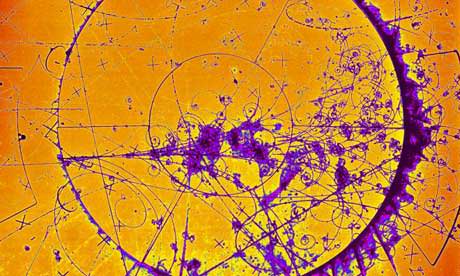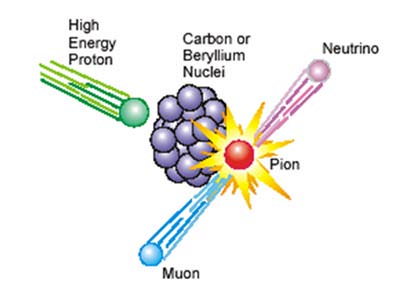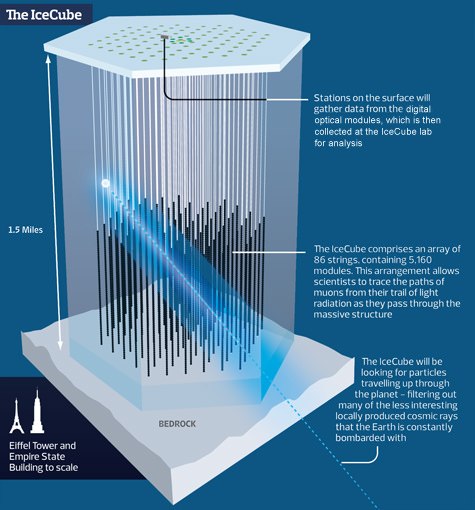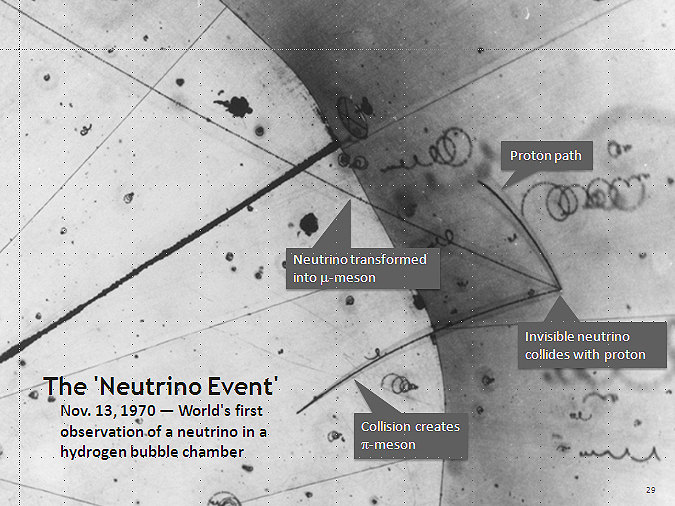[/caption]
Earlier this year, an international team of scientists announced they had found neutrinos — tiny particles with an equally tiny but non-zero mass — traveling faster than the speed of light. Unable to find a flaw themselves, the team put out a call for physicists worldwide to check their experiment. One physicist who answered the call was Dr. Ramanath Cowsik. He found a potentially fatal flaw in the experiment that challenged the existence of faster than light neutrinos.
Superluminal (faster than light) neutrinos were the result of the OPERA experiment, a collaboration between the CERN physics laboratory in Geneva, Switzerland, and the Laboratori Nazionali del Gran Sasso in Gran Sasso, Italy.

The experiment timed neutrinos as they traveled 730 kilometres (about 450 miles) through Earth from their origin point at CERN to a detector in Gran Sasso. The team was shocked to find that the neutrinos arrived at Gran Sasso 60 nanoseconds sooner than they would have if they were traveling at the speed of light in a vacuum. In short, they appeared to be superluminal.
This result created either a problem for physics or a breakthrough. According to Einstein’s theory of special relativity, any particle with mass can come close to the speed of light but can’t reach it. Since neutrinos have mass, superluminal neutrinos shouldn’t exist. But, somehow, they did.
But Cowsik questioned the neutrinos’ genesis. The OPERA experiments generated neutrinos by slamming protons into a stationary target. This produced a pulse of pions, unstable particles that were magnetically focused into a tunnel where they decayed into neutrinos and muons (another tiny elementary particle). The muons never went further than the tunnel, but the neutrinos, which can slip through matter like a ghost passes through a wall, kept going towards Gran Sasso.

Cowsik’s and his team looked closely at this first step of the OPERA experiment. They investigated whether “pion decays would produce superluminal neutrinos, assuming energy and momentum are conserved,” he said. The OPERA neutrinos had a lot of energy but very little mass, so the question was whether they could really move faster than light.
What Cowsik and his team found was that if neutrinos produced from a pion decay were traveling faster than light, the pion lifetime would get longer and each neutrino would carry a smaller fraction of the energy it shares with the muon. Within the present framework of physics, superluminal neutrinos would be very difficult to produce. “What’s more,”Cowsik explains, “these difficulties would only increase as the pion energy increases.
There is an experimental check of Cowsik’s theoretical conclusion. CERN’s method of producing neutrinos is duplicated naturally when cosmic rays hit Earth’s atmosphere. An observatory called IceCube is set up to observe these naturally occurring neutrinos in Antarctica; as neutrinos collide with other particles, they generate muons that leave trails of light flashes as they pass through a nearly 2.5 kilometre (1.5 mile) thick block of clear ice.

IceCube has detected neutrinos with energy 10,000 times higher than any generated as part of the OPERA experiment, leading Cowsik to conclude that their parent pions must have correspondingly high energy levels. His team’s calculations based on laws of the conservation of energy and momentum revealed that the lifetimes of those pions should be too long for them to decay into superluminal neutrinos.
As Cowsik explains, IceCube’s detection of high-energy neutrinos is indicative that pions do decay according to standard ideas of physics, but the neutrinos will only approach the speed of light; they will never exceed it.
Source: Pions Don’t Want to Decay into Faster the Light Neutrinos


Isn’t this sort of refuting an observation using a theory that the observation refutes? 🙂
Not really, they check their predictions with the IceCube.
No they didn’t. IceCube just saw high energy Neutrinos and they then used their backwards logic to say IceCube observed high energy neutrinos so they couldn’t go faster than light. They used IceCube because some people are aware that IF IceCube makes a particular observation then we can toss out the OPERA data easily. The observation is high energy neutrinos correlated to an even like a gamma ray pulse. So far they have not made such an observation and per the existing data and the rate of pulses they should have had between 2 and 6 such events. But they have 0 which puts some weight to the OPERA claim since if High Energy Neutrinos Generated In A Gama Ray Pulse are traveling at FTL then the standard method of matching them up by assuming they were traveling ether at or slightly less than the speed of light won’t work because the Neutrinos would arrive Years ahead of the pulse, and if the speed they travel is proportanal to their energy but are never slower then the speed of light that would explain supernova 1987a where the neutrinos arrived 3 hours earlier then they should have.
Yes, that is called testing, of the accepted theory.
There will be independent testing of the observations of OPERA sometime in the future.
Here’s the link to the relevant paper:
Superluminal Neutrinos at OPERA Confront Pion Decay Kinematics
Seems OPERA is burned from both ends. First ftl neutrinos should display relativistic Cherenkov radiation, now the neutrino generation doesn’t leave room for ftl energetics.
If OPERA’s neutrinos are close to light speed in vacuum, we could reverse the experiment. This may be the first check that GPS coordinates are correct. And if so, they are out some ~ 20 m at the CERN-OPERA distance. Maybe Earth is smaller than we thought. =D
They are trying all the time to kill the results of the Opera experiment, but actually it did nothing else but to confirm the Minos experiment, hints about faster than light neutrinos, albeit with more accuracy.
The OPERA results conflict with MINOS. MINOS found not FTL neutrinos.
LC
Actually Minos found nothing. They had a margin of error that made the neutrinos go ether FTL or very close to the speed of light. Opera increased the accuracy and they ended up eliminating the option of them going the speed of light if their measurements are true.
That is true. MINOS however found no FTL neutrinos, which is contrary to what mjolnar seems to be claiming. Actually the biggest contradiction is with SN1987`, where the neutrinos would have arrived about 4 years before they did based on the OPERA results.
LC
They are trying all the time to kill the results of the Opera experiment, but actually it did nothing else but to confirm the Minos experiment, hints about faster than light neutrinos, albeit with more accuracy.
The idea works like this. This gets a bit technical, but for those familiar with some physics this should be understood. Suppose you have two particles with 4-momentum k1 and k2 which scatter. In this case these correspond to the momentum of the nucleus and the proton. We can transform this problem to the center of mass frame. The 4-mometa have a spatial component and a temporal component so k1 = (p1, E1) and k2 = (p2, E2), with p2 = p1 in the center of mass frame. Now add these two k1 + k2 = E1 + E2, and square them
(k1 + k2)^2 = (E1 + E2)^2
which equals the pion mass m^2. These in turn scatter off to generate the neutrino and muon with k3 and k4, where again
(k3 + k4)^2 = (E3 + E4)^2 = m^2
Now we suppose the neutrino is moving faster than light. This results in something funny. The invariant mass of a particle is m^2 = E^2 – p^2 (energy squared minus momentum squared). The dispersion or velocity of the particle is given by v = ?E/?p where E = sqrt{p^2 + m^2}. Thus ?E/?p = p/E. For p >> m
E = p sqrt{1 + (m/p)^2} ~= p(1 + (1/2)(m/2p)^2)
And v = p/E ~= 1 – (m/2p)^2. For a real mass E > p, but for an imaginary mass p > E and we have a faster than light velocity.
We now use this result in the scattering momenta above. The pion mass is then
m_?^2 = (m_? + m_?)^2
from the k3 and k4 scattering. Hence the pion mass is composed of two real valued m_?^2 and m_?^2, which incidently is less than zero, plus an imaginary valued 2m_?m_? from the cross term in the square. Then something odd is happening here, where the mass of the pion must be some higher mass on the Regge trajectory (the two quarks are spun up into a rotation like a rotating baton). Further, the decay of the pion is given by a term e^{-?t}, where that Gamma term is given by the mass of the pion. Well there is this imaginary product of the masses, which means that some of the decay process is converted into an oscillation because of the i = sqrt{-1}. The decay will instead of being a pure exponential decay will have a smaller decay and an oscillation given by e^{i?t} = cos(?t) + i sin(?t).
LC
‘Within the present framework of physics, superluminal neutrinos would be very difficult to produce’.
Substitute impossible for very difficult. If they ever prove FTL neutrinos, we will have dump the present framework of physics.
Isn’t it fascinating to know we might need to revise some of our theories of physics? This is how science works, and I for one can’t wait to see how it all pans out! A result either way will be so interesting -and a big plus is that now people who would not normally think about physics are starting to discuss it and make an effort to understand what’s going on….. I love it 🙂
“”Isn’t it fascinating to know we might need to revise some of our theories of physics?””
Hahah this is an understatement. It appears that our substrate may be far deeper, and ultimately incomprehensible.
The big problem is the quantum vacuum state would be unstable. Relativity can well enough permit faster than light partciles. Just as slower than light particles can’t be accelerated to faster than light, faster than light particles (tachyons) can’t be accelerated to slower than the speed of light. The basic bosonic string theory has 2 tachyon states. These can be removed by various mathematical tricks — fortunately. The biggest problem is that the vacuum minimum is at the top of a potential hill, rather than being at the bottom of a potential well. Things would be horrendously unstable, and the vacuum would be showering forth a constant bath of radiation.
LC
“…can be removed by various mathematical tricks-” ?
You mean like the way they ‘solved’ the square root of a negative number? What is that constant called again? The one that “removed” the problem?
Oh Yeah…they denote it with an italic small “i” and have the audacity to call it ‘the imaginary number”
Some trick.
The identification of i = sqrt{-1}, or i^2 = -1, is really a definition, and it permits the mathematics of complex numbers. These are numbers z = a + ib on a plane with real and imaginary numbers. This is a sort of pairing of real numbers with a multiplication rule that emulates i^2 = -1. It is not hard writing a computer program that does this, and I have written a number of numerical quantum mechanics algorithms that does this. There is the next level which involves pairs of complex numbers, called quaternions. These are four dimensional and noncommutative. Then you can go further with pairs of quaternions in 8 dimensions, the octonions, which are not associative.
The tachyons have m^2 < 0 and so is imaginary valued. These are removed by certain cancellations of quantum states. One might think of it as a situation where anything traveling faster than light escapes out to infinite and is then outside the theory.
LC
Sorry, but you missed my point.
The “imaginary number”, which does not ‘in fact’ exist, was defined to ‘remove a problem’ which ‘real numbers’ couldn’t….a mathematical “trick”.
It defines an imaginary relationship between real numbers and ‘numbers’ which are not real.
We are now at that point where relativity (the real) seems to break down. Perhaps these ‘possibly FTL’ neutrinos exist but are ‘imaginary’ in the same way…admitting their existence, allowing them a definition, will permit us to “remove the problem” and get a glimpse of the Irrelative.
In other words…Do you think it is possible that our total universe/multiverse/mess of strings (ie; relativity) is simply the other side of “somebody elses event horizon”?
A mathematical object exists if it can work in a consistent way in a mathematical structure. There are a whole lot of things which defy ordinary sense of math, such as Teichmuller spaces, K3 manifolds, nonassociative octonions, an infinite number of four dimensional manifolds that have no differential structure and so forth.
LC
Are you a wizzard?
0_0
That is to say, it is proven without a doubt! And proven really means proven.
I would like to learn more. We will both be watching as these ‘curious results’ are refined and disected, reinterpreted and retested.
The mindset that demands FTL neutrinos “cannot exist dismisses the possibility that an FTL neutrino is not a neutrino.
Still…
The mathematical ‘trick’ of inducing imaginary numbers, turns out to give direct mathematical explanations to real world problems. That perfectly justifies it, because that means we can test it and verify it.
Science doesn’t prove (except in the archaic sense of the word) things, it disproves other things. What remains is further tested until a very high confidence level is established that it likely cannot be falsified.
If, in fact, distance and timing error claims turn out to be confidently falsified, what remains will be some kind of FTL phenomenon, but not necessarily outside the boundaries of standard relativistic theory: it could be some kind of group-velocity measurement that does not involve FTL signal violation.
And if that is established, it will still not be established whether individual neutrinos’ v>c, in dense matter. SN1987a has reasonably established v=c, in vacuo.
This piece was so well written, I could almost understand the subject! ( Illustrations were helpful. )
This piece was so well written, I could almost understand the subject! ( Illustrations were helpful. )
According to Einstein’s postulates, no matter can cross the light speed threshold. THEREFORE, there were no FTL neutrinos. That hardly seems to address the issue of having gauged them at slightly FTL. We get that they shouldn’t, and to everyone, is seems impossible. I won’t be interested in all these other scientists telling us WHY until they tell us HOW the experiment went wrong. Not to mention, how can they possibly tell us what an impossible particle would do? Impossible particles can do whatever they like. (:
So what they “proved” is FTL neutrinos should not exist. Something we already know. The real question is WHY Opera experiment shows FTL neutrinos.
Exactly. I thought somebody was setting up to duplicate the experiment. That still needs to be done so they can figure out what was wrong to avoid errors in future experiments, or perhaps there is still SOMETHING interesting going on in these experiments, even if it is not superluminal neutrinos.
If the OPERA results were in fact valid, accepting the rather substantially different experimental setup of IceCube’s (prospective) luminal results would tell us nothing about what happens when neutrinos are thrown through 750 kilometers of rock.
Why bother? SN1987a has already given us substantially the same as the desired IceCube result as prettily as we could please.
Several minor papers have, in fact, pro-actively explained potential mechanisms why that stony barrier might actually provoke a (causality-valid) apparent FTL signature.
The implications would be practically non-trivial; it would require a re-write of the working equations for propagation through dense matter: solar, stellar, supernova detonation and so forth.
Last name is not Cowsik… Its likely Kaushik.
Somebody I assume wrote the name down as pronounced.
it seems to me that what was actually ascertained was a greater accuracy of the distance measurement between the two points.
The name is Cowsik – that’s how it’s spelled in the paper (see the link).
In the special theory of relativity the Lorentz transformation replaces the Gallilei transformation and there you find an absolute term ‘c’, called ‘speed of light’. It should have a value close to the speed of light in vacuum, not at all less than it. But has there ever been a measurement that tells with an uncertainty of less than 0.002% that it has exactly that value ? In the KATRIN experiment they try to find out the rest mass of the neutrino – and if I calculated correct, a difference of 0.003% in the energy according to E = m c^2 would mean less than the expected mass of the neutrino. Maybe, that by using the formula m = m(0) / SQRT( 1 – v^2/c^2), that describes the relativistic rise of the particles mass, the value of that c can be identified. But is such a measurement realy done yet ?
OPERA Experiment and its flawed GPS Measurements cause neutrinos to appear superluminal. Relativistic Time is where flaw is, since GPS adjusts time according to relativity’s equations. However, being confused about time has always been a tradition amongst physicists; we show below how physicists never even understood the nature of time in classical physics!
What fantastic claim be shown by doing an OPERA-like experiment to measure speed of light instead of neutrinos? It can be shown that not only do neutrinos travel faster than light, but light travels faster than itself too! Of course light cannot travel faster than itself (and you don’t have to be an Einstein to realize that)!
Speed = Distance / Time. If measured this way the neutrinos will not be faster than light, provided Distance and Time can be correctly measured. But OPERA used the latest technology – GPS, which adjusts time according to relativity’s equations. So in OPERA’s physics, Speed = (GPS Measured Distance) / (GPS Measured Time). You can get neutrinos back under light speed if you can eliminate GPS from the measurements. Relativity-worshipping physicists can (and probably will) escape the faster-than-light neutrinos dilemma by dodging GPS and thus dodging relativistic time equations. So relativity-worshippers may well have the last laugh. But look at the irony – they have to dump relativity’s time adjustments to fix the neutrino issue and save relativity’s light postulate!
We have been saying since 2005 in our paper at physicsnext.org that, while different observes will measure different times in many cases, Einstein time-dilation equations are wrong, and we give the correct equations. Our paper at physicsnext.org has a COUNTER-EXAMPLE exists that PROVES that (though Einstein’s postulates are correct), Einstein’s claim of having derived the Lorentz transformations is wrong; yes a COUNTER-EXAMPLE — and at least one Nobel prize winner takes this realization seriously.
Forget Einstein’s equations about time dilation, even Einstein’s claim about time itself being an independent physical quantity (his equations require this) is wrong. Our paper at physicsnext.org also shows how to build a clock that will not undergo any time dilation at all.
Physicists are wrong even about what “classical physics” (i.e.pre-Einstein physics) said about time. Physics books widely state that in classical physics time was “absolute ” by which they mean that is was an independent quantity that “flows” at a constant pace. No equation of classical physics implies any such thing about time, and if physics is equations then these writers failed to even understand Newton’s laws and equations, and what these equations imply about time. (They went for some Newton quotation from here and there, but those quotes are not physics, they are just secondary opinion with no physics to back it up. You can either go after the superfluous OR you can try to understand physics and what it implies; physics writers have unanimously chosen the former when it comes to Newtonian Physics and Time). Einstein’s physics and Einstein’s equations were the first time that physics was required incorporate the claim that time “flows” as an actual independent physical quantity; this claim about time we consider to be highly questionable philosophically, and this was a major motivation in our finding alternative equations that are consistent with Einstein’s two postulates.
Below paragraph, taken unedited from p.7 of our paper at physicsnext.org, gives the actual situation about classical and relativistic time.
While doing away with the concept of “absolute time,” relativity presented a new thesis of “relative time flow” between inertial frames. We do not take the absolute time of Newtonian physics to have meant that time itself “flows” as an independent physical quantity — it only meant that the equations worked in such a way that all observers measured the same time for the same event. We could attempt to make a similar statement about observers in different frames and relativity’s relative time — however, in relativity time is an independent physical quantity and we have actual time dilation.